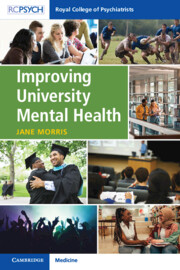Book contents
- Improving University Mental Health
- Improving University Mental Health
- Copyright page
- Contents
- Foreword
- Acknowledgements and Thanks to Contributors
- Chapter 1 Introducing This Handbook
- Chapter 2 Building a New Sense of Belonging
- Chapter 3 The Transition to University for New Students with Pre-Existing Mental Conditions
- Chapter 4 The Roles of Parents and Carers
- Chapter 5 Healthy Bodies, Body Image Concerns, Eating Disorders
- Chapter 6 Alcohol
- Chapter 7 Substance Misuse
- Chapter 8 Social (and Anti-social) Media
- Chapter 9 Finance and Mental Health
- Chapter 10 Neurodiversity
- Chapter 11 Ethnically Diverse University Communities
- Chapter 12 Sexual Behaviour and Gender Identity in Universities
- Chapter 13 The Mental Health of Teaching and Academic Staff
- Chapter 14 An Overview of Mental Disorders in Students and Staff
- Chapter 15 ‘Psychotic’ Disorders
- Chapter 16 Mood Disorders
- Chapter 17 Suicide at University
- Chapter 18 Mental Health Services on Campus and in the NHS
- Chapter 19 Students of the Professions and ‘Fitness to Practise’ Issues
- Chapter 20 Summing It All Up
- Index
- References
Chapter 11 - Ethnically Diverse University Communities
Challenges for Students and Staff from Black, Asian and Other Minority Ethnic Backgrounds
Published online by Cambridge University Press: 08 February 2024
- Improving University Mental Health
- Improving University Mental Health
- Copyright page
- Contents
- Foreword
- Acknowledgements and Thanks to Contributors
- Chapter 1 Introducing This Handbook
- Chapter 2 Building a New Sense of Belonging
- Chapter 3 The Transition to University for New Students with Pre-Existing Mental Conditions
- Chapter 4 The Roles of Parents and Carers
- Chapter 5 Healthy Bodies, Body Image Concerns, Eating Disorders
- Chapter 6 Alcohol
- Chapter 7 Substance Misuse
- Chapter 8 Social (and Anti-social) Media
- Chapter 9 Finance and Mental Health
- Chapter 10 Neurodiversity
- Chapter 11 Ethnically Diverse University Communities
- Chapter 12 Sexual Behaviour and Gender Identity in Universities
- Chapter 13 The Mental Health of Teaching and Academic Staff
- Chapter 14 An Overview of Mental Disorders in Students and Staff
- Chapter 15 ‘Psychotic’ Disorders
- Chapter 16 Mood Disorders
- Chapter 17 Suicide at University
- Chapter 18 Mental Health Services on Campus and in the NHS
- Chapter 19 Students of the Professions and ‘Fitness to Practise’ Issues
- Chapter 20 Summing It All Up
- Index
- References
Summary
Better nurturing of ethnic diversity can be associated with improved academic achievement as well as more ethical university communities. Despite ‘wake up calls’ such as the Black Lives Matter movement, there is no room for complacency. The UK does not have predominantly black universities, though student cultural societies allow a sense of belonging. Individuals from minority ethnic groups should not automatically have to take responsibility as BAME campaigners. White staff and students need to overcome defensiveness to prevent ‘white fragility’ from blocking progress. In choosing a university, families of all ethnicities can ask whether the institution is signed up to Advance HE’s race equality charter (REC). Staff should assertively support BAME staff appointments and grant applications, and ensure that racial awareness trainings are evidence based. University Disciplinary procedures need to offer greater openness to complaints of discrimination and harassment. In University counselling services appointing more BAME practitioners improves the ethnic diversity of the clinical group, whether or not clients opt to meet with a clinician of non-white ethnicity. BAME students need extra support to return to academia after a mental illness as they are at greater risk of ‘dropping out’.
Keywords
- Type
- Chapter
- Information
- Improving University Mental Health , pp. 160 - 177Publisher: Cambridge University PressPrint publication year: 2024



